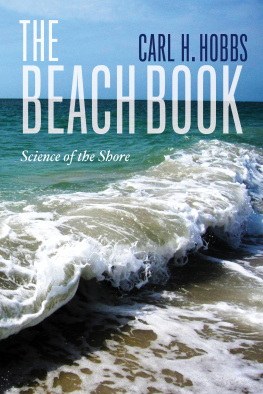A Global Look at the Beach Environment and How We Use It
BEACHES IN SPACE AND TIME
Richard A. Davis Jr.

Dedicated to my kids and grandkids;
they all love the beach!
Copyright 2015 by Richard Davis
All rights reserved. No part of this book may be reproduced in any form or by any means, electronic or mechanical, including photocopying, recording, or by any information storage and retrieval system, without permission in writing from the publisher.
Inquiries should be addressed to:
Pineapple Press, Inc.
P.O. Box 3889
Sarasota, Florida 34230
www.pineapplepress.com
Library of Congress Cataloging-in-Publication Data
Davis, Richard A., Jr.
Beaches in space and time : a global look at the beach environment and how we use it / Richard Davis. First Edition.
pagescm
Includes bibliographical references and index.
ISBN 978-1-56164-733-0 (pbk. : alk. paper)
1. Beaches. 2. Seashore ecology. I. Title.
GB450.2.D386 2014
551.457dc23
2014020229
First Edition
10 9 8 7 6 5 4 3 2 1
Design: Doris Halle
Printed in the United States
Contents
Wind, waves, tides, and storms control the nature of the beach. |
The materials that compose the beach range widely in composition and grain size. They can originate near to and very far from the beach. |
Sea level has been rising for thousands of years, but the rate seems to be increasing and could cause problems for our beaches. |
Development on the upland environment, structures on the shoreline and in the nearshore, building new beachesall can help or cause problems for the health of the beach. |
Many places in the world have unique, beautiful, and unusual beaches. |
Beaches are not only great places to recreate, they have played a role in wars, they host various sports, they are featured in movies, and they inspire artists to feature the beach. |
Preface
The title of this book may bring to mind odd images of sandy beaches on Einsteins space-time continuum, but if you think like a geologist, space just means somewhere on our planet and time means, well, that ordinary progression most people think it means. But time in the geological sense can mean a very long progression measured in millions of years.
The beach is one of the most visited places on the planet. Some folks go to the same one over and over for recreation. Others may be more curious and visit many different beaches. Those who are very committed to the beach often choose to live on it or very near it. Some will have a second home at the beach for frequent visits.
Beaches exist everywhere on earth from the Arctic to the Antarctic all around the globe. We normally think of the beach as a place where water meets the land with sand. That is certainly true for most beaches, but there are wide variations in kinds of beaches. Some beaches are muddy, some strewn with boulders; some are wide and flat, others narrow and steep. The other aspect of the beach environment that is present everywhere is the presence of waves. There is great variation in waves in both space and time. The location of a beach pretty much dictates the wave climate. Weather is a major factor in many ways. The orientation of the shoreline relative to the approach of the waves is also important. The geology of the coast adjacent to the beach, both its composition and its size, is also a factor in the nature of the beach.
This book is designed for the person who is fond of the beach and wants to learn about its character, how it functions, its variety around the globe, and how and why it is visited by so many folks for so many reasons. The many color photos illustrate and enhance the text to make the science of the beach more real to the reader. A glossary of terms is also provided.
Keep in mind that beaches change continuously and that major changes can occur in a single day during a storm. For those reasons there are photographs in the book that were taken some years ago that will show a beach that looks different at this time.
You will note that many of the photos are credited to various sources and people. Their generosity in making them available for inclusion is greatly appreciated. Several of the diagrams have been produced or modified by Fabio Moretzshon. The Harte Research Institute for the Gulf of Mexico at Texas A&M UniversityCorpus Christi provided a variety of support for the production of the manuscript.
Beach Processes
INTRODUCTION
Scientists have determined that the earth is 4.6 billion years old. It began as a huge dust cloud of diverse gases that consolidated through the action of gravity, forming a mass that evolved into the earth. The lithosphere, hydrosphere, and atmosphere evolved, and a semblance of an equilibrium system among these three systems developed. The lithosphere had a largely volcanic source that eventually became the three main layers of the crust, mantle, and core. Included in the crust are igneous, sedimentary, and metamorphic rocks. Volcanic activities were widespread, expelling water vapor that eventually produced the hydrosphere. Most of the hydrosphere rested on the lithosphere and included the oceans, lakes, and streams. There was also groundwater beneath the surface of the lithosphere. The uppermost layer is the atmosphere, primarily composed of nitrogen and hydrogen as well as other gases. Oxygen came somewhat later as volcanic activity proceeded. As the oceans evolved, they accumulated salinity from the chemical erosion of minerals and eventually established a dynamic equilibrium that maintains the salinity concentration as we know it today.
These conditions provided the basis for our present surface environments, both on the land and in the sea. Many of these can be seen in a diagram of the hydrologic cycle (erosion. Streams also deposit sediment as sand bodies in the channels and as widespread mud deposits on the flood plains. The streams may feed lakes that form in small to large enclosed basins on the land surface, or they may empty into the ocean. Rain also penetrates into the lithosphere to become part of the groundwater.

Figure 1.1
Hydrologic cycle showing the main elements of the earths surface
The earths surface includes mountains and plains with coasts and ocean basins. Streams carry erosion-produced sediment to their mouths, where it can be deposited as deltas or moved along the coast as beaches. A beach is simply unconsolidated sediment along the shoreline regardless of composition or particle size. The sediment may reach the shoreline via transport by streams, it also might be eroded directly from the rocks in cliffs or bluffs along the shoreline, or it might be reworked by waves and currents from older sediment in the shallow water near the shoreline. Most characteristics of the beach have been fairly typical since the beginning of time, but some things have changed. The changes have been produced by the evolution of various plants and animals, especially humans. We know that humans can alter their environment, and the beach is certainly included.












